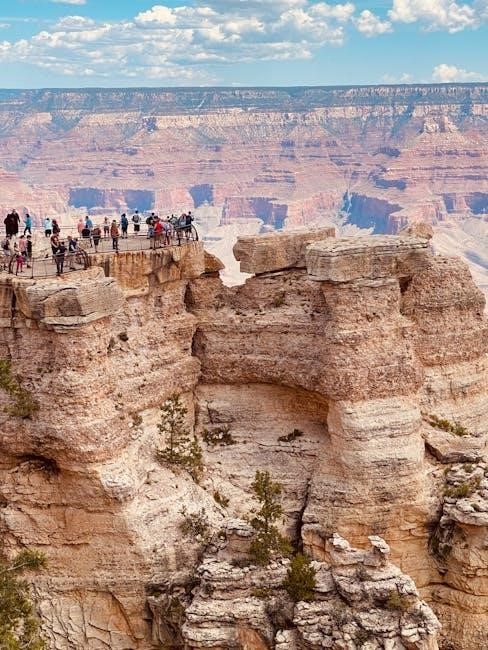Unit 3 explores cultural patterns, diffusion, and identity, offering insights into how cultures shape landscapes. Practice tests and study guides are available for comprehensive preparation and review.
1.1 Overview of Unit 3: Cultural Patterns and Processes
Unit 3 delves into the dynamics of cultural patterns and processes, examining how cultures diffuse, evolve, and interact. It explores key concepts like folk and popular culture, cultural landscapes, and the role of language and religion. Students analyze migration’s impact on cultural diversity and the challenges of globalization. The unit also covers ethnicity, identity, and acculturation, providing a comprehensive understanding of cultural geography. Practice tests and study guides are essential for mastering these concepts and preparing for the AP exam.
1.2 Importance of Understanding Cultural Geography
Understanding cultural geography is crucial for grasping how human activities shape and are shaped by cultural practices. It helps analyze global issues like globalization, migration, and cultural conflicts. By studying cultural geography, students gain insights into identity, traditions, and cultural diffusion. This knowledge fosters cultural sensitivity and prepares individuals to navigate diverse societies. In the context of the AP exam, mastering cultural geography enhances critical thinking and problem-solving skills, essential for addressing real-world challenges and excelling in academic assessments.
1.3 Key Themes and Concepts in Unit 3
Unit 3 focuses on cultural components, diffusion, language, religion, ethnicity, and cultural landscapes. Key concepts include folk vs. popular culture, relocation diffusion, and the role of language and religion in shaping identity. Ethnicity and acculturation processes are explored, along with how migration impacts cultural diversity. Understanding these themes is essential for analyzing cultural patterns and their global implications, preparing students for both the AP exam and real-world applications of cultural geography.
Cultural Components and Processes
Cultural components include beliefs, practices, and artifacts. Processes like diffusion, acculturation, and assimilation shape cultural landscapes, influencing identity and diversity across global regions and communities.
2.1 Definition and Elements of Culture
Culture refers to the shared beliefs, values, behaviors, and artifacts of a group. Key elements include language, religion, customs, and social norms, which shape identity and daily life. These components are transmitted through learning, influencing how people interact and adapt to their environments. Understanding culture’s complexity is crucial in AP Human Geography, as it forms the foundation for analyzing cultural patterns and processes. Practice tests often assess comprehension of these elements and their interconnections.
2.2 Folk Culture vs. Popular Culture
Folk culture is traditional, localized, and transmitted through direct interaction, often tied to customs and practices of small, homogeneous groups. In contrast, popular culture is widespread, modern, and mass-produced, influenced by media and technology. Folk culture relies on relocation diffusion, while popular culture spreads rapidly through expansion diffusion. Understanding these distinctions is key to analyzing cultural patterns, as practice tests often focus on identifying examples of each and their geographic implications.
2.3 Cultural Diffusion: Types and Examples
Cultural diffusion refers to the spread of cultural traits, ideas, or innovations from one place to another. It occurs through relocation, expansion, or stimulus diffusion. Relocation diffusion involves the physical movement of people, such as the spread of Islam through migration. Expansion diffusion occurs through trade or media, like the global popularity of fast food chains; Stimulus diffusion involves adapting ideas, such as the influence of Buddhism on other philosophies. Understanding these types and examples is crucial for analyzing cultural patterns in AP Human Geography Unit 3 practice tests.

Language and Religion in Cultural Geography
Language and religion shape cultural identity, influencing global patterns. Major language families like Indo-European dominate, while religions such as Islam spread through relocation diffusion, impacting cultural landscapes significantly.
3.1 Role of Language in Shaping Culture
Language is a cornerstone of culture, transmitting traditions, values, and histories. It shapes identity, fostering unity within groups and separation between them. Indigenous languages, often tied to specific landscapes, reflect unique cultural practices. For example, the Amish maintain their dialect to preserve isolation. Language also influences cultural diffusion, as seen in the spread of Arabic with Islam. Understanding linguistic diversity helps explain global cultural patterns and the role of language in shaping human geography.
3.2 Major Language Families and Their Distribution
Major language families, such as Indo-European, Sino-Tibetan, and Afro-Asiatic, dominate global linguistic landscapes. Indo-European spans Eurasia, including English, Spanish, and Hindi. Sino-Tibetan is prevalent in East Asia, with Mandarin and Tibetan dialects. Afro-Asiatic covers Arabic, Hebrew, and Swahili across Africa and the Middle East. These families often correlate with historical migration patterns and cultural diffusion, shaping regional identities. Understanding their distribution aids in analyzing cultural and ethnic diversity, as seen in Unit 3 practice materials and test PDFs.
3.3 Religion as a Cultural Force: Types and Examples
Religion significantly influences cultural identity, values, and practices. Major religions like Christianity, Islam, and Buddhism shape societal norms and traditions. Islam, for instance, is growing rapidly due to high birthrates and relocation diffusion. Christianity dominates Western cultures, while Hinduism and Buddhism are deeply rooted in Asian traditions. These religions often diffuse through contagious and relocation diffusion, impacting cultural landscapes. Understanding their roles is crucial for analyzing cultural geography, as seen in Unit 3 practice tests and PDF resources, which include questions on religious patterns and their global influence.
Ethnicity and Identity
Ethnicity shapes cultural identity, influencing geographic patterns. Ethnic regions reflect unique traditions, while processes like acculturation and assimilation impact cultural diversity and societal integration.
4.1 Defining Ethnicity and Its Impact on Geography
Ethnicity refers to shared cultural traits, such as language, religion, and customs, that define a group’s identity. It significantly influences geography by shaping cultural landscapes, migration patterns, and regional boundaries. Ethnic groups often cluster in specific areas, creating distinct ethnic regions. These regions reflect the cultural practices and traditions of their inhabitants, impacting the social, economic, and political dynamics of the surrounding areas. Understanding ethnicity is crucial for analyzing how cultural identity interacts with geographic space and societal structures.
4.2 Ethnic Regions and Their Cultural Significance
Ethnic regions are areas where a specific ethnic group forms the majority, preserving unique cultural practices. These regions often exhibit distinct languages, religions, and traditions, enriching global diversity. They serve as cultural hubs, maintaining heritage through customs and architecture. Ethnic regions also influence local economies and politics, shaping identities and community cohesion. Their cultural significance lies in preserving history and fostering resilience against globalization, making them vital for understanding human geography and cultural persistence.
4.3 Acculturation and Assimilation Processes
Acculturation and assimilation are key processes in cultural adaptation. Acculturation involves blending cultural practices, while assimilation is the adoption of a dominant culture, often leading to loss of original traits. These processes are driven by migration, globalization, and social interactions. Assimilation can result in cultural homogenization, whereas acculturation preserves some cultural identity. Both shape ethnic dynamics, influencing societal integration and diversity. Understanding these concepts is crucial for analyzing cultural change and its impacts on communities in AP Human Geography Unit 3.

Cultural Landscapes and Their Significance
Cultural landscapes reflect the interaction between humans and their environment, shaped by practices, beliefs, and histories. They include physical modifications like architecture and land use, preserving cultural identity and heritage.
5.1 Cultural Landscapes: Definition and Examples
Cultural landscapes are tangible representations of a society’s heritage, combining natural and human-made features. Examples include the Amish countryside, Islamic cities, and sacred religious sites. These landscapes reflect cultural values, traditions, and histories, serving as living archives of human activity. They are shaped by practices like agriculture, architecture, and art, preserving identity and fostering community cohesion. Understanding these landscapes is crucial for grasping how cultures interact with and transform their environments over time.
5.2 Impact of Culture on Natural Landscapes
Cultural practices profoundly influence natural landscapes, shaping their form and function. Religious beliefs, for instance, often dictate land-use patterns, such as Islamic gardens reflecting spiritual harmony. Ethnic traditions, like terraced farming in Asia, adapt to terrain while preserving biodiversity. Additionally, cultural values determine resource management, influencing deforestation rates or conservation efforts. These interactions highlight how human activities, guided by cultural norms, transform ecosystems, creating a mosaic of natural and cultural elements intertwined across the globe.
5.3 Preserving Cultural Landscapes in a Globalized World
Cultural landscapes, shaped by traditions and beliefs, face threats from globalization, which often erodes unique local practices. Efforts to preserve these landscapes involve safeguarding historical sites, promoting indigenous knowledge, and supporting community-based initiatives. UNESCO World Heritage designations and legal protections play a crucial role in maintaining cultural integrity. Additionally, educating future generations about the significance of these landscapes ensures their survival. By balancing modernization with cultural heritage, societies can maintain their distinct identities in an increasingly interconnected world.
Migration and Its Cultural Implications
Migration drives cultural exchange, altering landscapes through demographic shifts and ethnic diversity, while shaping identity transformation in both origin and destination regions.
6.1 Migration Patterns and Their Cultural Effects
Migration patterns significantly influence cultural landscapes, leading to ethnic diversification and the blending of traditions. For instance, the movement of refugees often introduces new languages and customs, enriching local cultures but sometimes causing tensions. Economic migrants bring skills and labor, reshaping workforce dynamics. Additionally, migration facilitates the spread of popular culture, such as music and cuisine, through relocation diffusion, creating a mosaic of cultural identities in urban areas. These changes highlight migration’s dual role in preserving heritage and fostering cultural evolution.
6.2 Relocation Diffusion and Its Role in Cultural Change
Relocation diffusion occurs when people migrate, carrying their cultural practices to new regions. This process significantly impacts cultural change by introducing new traditions, languages, and beliefs. For example, the spread of Islam through migration exemplifies how relocation diffusion can reshape cultural landscapes. It fosters diversity but may also lead to cultural blending or displacement. Understanding this concept is crucial for analyzing how migration drives global cultural evolution and shapes identity in both origin and destination regions. Effective study strategies and practice tests can help master this topic.
6.3 Migration’s Impact on Ethnic and Cultural Diversity
Migrations significantly influence ethnic and cultural diversity by transferring traditions, languages, and beliefs across regions. This movement fosters cultural exchange, creating diverse societies like the United States, often described as a cultural mosaic. However, migration can also lead to tensions, as incoming groups may challenge existing cultural norms. Ethnic enclaves form, preserving identities while adapting to new environments. Such dynamics highlight migration’s dual role in enriching and complicating cultural landscapes, making it a key focus in understanding global diversity and its challenges.
Case Studies in Cultural Geography
Case studies highlight cultural preservation, diffusion, and diversity, such as the Amish community, the spread of Islam, and ethnic diversity in the United States.
7.1 The Amish Community: A Case of Cultural Preservation
The Amish community exemplifies cultural preservation through adherence to traditional practices, rejecting modern technology. Their concentration in Pennsylvania reflects cultural resilience and isolation, maintaining distinct practices despite surrounding modernization.
7.2 The Spread of Islam: A Relocation Diffusion Example
The spread of Islam illustrates relocation diffusion, as Arab conquests and trade expanded its reach. Key events, like the Hijra, facilitated its growth. Islam’s expansion into the Middle East, North Africa, and beyond exemplifies how relocation diffusion disperses cultural and religious practices, adapting to local contexts while maintaining core beliefs.
7.3 Ethnic Diversity in the United States: A Cultural Mosaic
The United States exemplifies a cultural mosaic, shaped by centuries of immigration. Ethnic diversity is a defining feature, with groups like African Americans, Hispanics, Asians, and Native Americans contributing to the nation’s identity. This diversity reflects the country’s history of migration and its role as a global melting pot.
Cultural practices, languages, and traditions from various ethnic groups enrich American society. However, this diversity also presents challenges, such as social inequality and cultural assimilation, making it a complex yet dynamic aspect of the nation’s geography.

Practice Materials for Unit 3
Access multiple-choice questions (MCQs) and free-response questions (FRQs) to practice cultural patterns, diffusion, and identity. Resources include test corrections and review guides for self-assessment.
8.1 Multiple-Choice Questions (MCQs) for Self-Assessment
MCQs for Unit 3 focus on cultural patterns, diffusion, and identity. These questions assess knowledge of key concepts like cultural landscapes, religion, and ethnicity. Students can identify strengths and weaknesses by reviewing answers and explanations. Topics include folk vs. popular culture, language families, and migration impacts. Regular practice with MCQs improves test-taking skills and understanding of cultural geography. Access these resources through online platforms or downloadable PDFs to enhance study routines and prepare effectively for the AP exam.
8.2 Free-Response Questions (FRQs) and Answers
FRQs for Unit 3 require detailed responses on cultural patterns and processes. Questions may ask about the spread of religions, ethnic identity, or cultural landscapes. Example questions include analyzing migration’s impact on diversity or explaining syncretism. Answers must demonstrate clear understanding and relevant examples. Scoring guidelines emphasize depth, clarity, and the use of geographic terminology. Practice FRQs are available in PDF formats, along with sample answers, to help students refine their writing and critical thinking skills for the AP exam.
8.3 Unit 3 Test Corrections and Review Guide
The Unit 3 Test Corrections and Review Guide provides detailed feedback on student performance. Available on the College Board account, it allows students to identify and address misunderstandings. To regain points, students must complete all FRQs using ACE. The guide includes explanations for correct answers and common errors. It also offers a Unit 3 Test Study Guide to review cultural patterns, diffusion, and identity. This resource helps students improve their understanding and prepare for future assessments, ensuring they grasp key concepts before the AP exam.

Study Tips and Resources
Effective study strategies include active note-taking, concept mapping, and regular practice with MCQs. Utilize recommended books, PDF guides, and online tools for comprehensive preparation and understanding of cultural geography concepts.
9.1 Effective Study Strategies for Unit 3
Master Unit 3 by organizing study sessions around key themes like cultural diffusion and identity. Use flashcards for vocabulary and concept mapping to visualize relationships. Regularly review practice questions and FRQs to identify weak areas. Allocate time for case studies, such as the Amish community, to deepen understanding. Engage actively with study guides and online resources to reinforce learning. Consistent practice and thorough review of test corrections will ensure readiness for the AP exam.
9.2 Recommended Resources: Books, PDFs, and Online Tools
Enhance your preparation with resources like the Barron’s and Kaplan AP Human Geography practice tests. Utilize Unit 3-specific PDFs, such as the Unit 3 Test Study Guide and FRQ Answers. Online platforms like AP Classroom and Khan Academy offer interactive tools. Flashcards and concept summaries are invaluable for memorizing key terms and concepts. Additionally, explore chapter-specific study guides and PowerPoint presentations for detailed insights into cultural patterns and processes.
9.3 Using Flashcards and Summarization Techniques
Flashcards are an excellent tool for memorizing key terms and concepts in Unit 3, such as cultural diffusion types and ethnic identity definitions. Create physical or digital cards to review regularly. Summarization techniques, like condensing notes into bullet points, help reinforce understanding. Use concept maps to visually connect ideas, such as linking folk culture to relocation diffusion. These methods ensure active engagement and retention of material, complementing practice tests and study guides for a well-rounded study approach.

Test-Taking Strategies
Master effective test-taking strategies for Unit 3 by practicing with sample questions, managing time wisely, and reviewing answer explanations to improve performance and confidence.
10.1 How to Approach Multiple-Choice Questions
When tackling multiple-choice questions, start by carefully reading each question and identifying key terms. Skim the answer choices to eliminate obvious distractors. Focus on the question stem and use process of elimination to narrow down options. If unsure, consider the context of the topic and relevant concepts from Unit 3. Manage your time by allocating a set amount per question, ensuring you complete the section within the allotted period. Practice with sample questions to build familiarity and improve your decision-making skills under exam conditions.
10.2 Mastering Free-Response Questions (FRQs)
To excel in FRQs, thoroughly understand the question and structure your response clearly. Begin with a strong thesis statement and organize your answer using paragraphs. Use specific examples from Unit 3, such as cultural diffusion or ethnicity, to support your arguments. Practice past FRQs to familiarize yourself with the format. Allocate time wisely, spending 20-25 minutes per question, and ensure you address all parts of the prompt. Review your work briefly before submission to correct errors and clarify points.
10.3 Time Management During the Test
Effective time management is crucial for success on the AP Human Geography exam. Allocate 45 minutes for the FRQ section, spending 20-25 minutes per question. Begin by reading all questions carefully to understand what is being asked. Prioritize questions you are most confident about first. Skim through the test to identify manageable sections early. Avoid spending too much time on a single question—move on and return if time permits. Leave 5-10 minutes at the end to review your answers and make necessary corrections.
Common Mistakes to Avoid
Common mistakes include misunderstanding key concepts, misinterpreting regional variations, and poor time allocation during exams. Address these by thorough preparation and careful question analysis.
11.1 Misunderstanding Key Concepts
Misunderstanding key concepts, such as cultural diffusion types or ethnicity definitions, can lead to incorrect answers. Regularly reviewing notes and practice questions helps clarify these concepts and ensures a strong foundation for the exam. Utilize study guides and flashcards to reinforce understanding, focusing on frequently tested topics like syncretism and acculturation. Addressing these misunderstandings early on improves overall performance and confidence during the test.
11.2 Overlooking Regional Variations
Overlooking regional variations in cultural practices and landscapes can lead to incorrect assumptions about cultural uniformity. For instance, assuming all adherents of a religion follow the same practices globally can result in errors. It is crucial to recognize how cultural traits vary across regions due to local influences. Utilize study guides and practice tests to identify and understand these variations, ensuring accurate responses. This attention to detail enhances your ability to analyze cultural patterns and processes effectively, avoiding oversimplification and improving test performance. Regional nuances are often key to answering free-response questions correctly.
11.3 Poor Time Allocation During the Exam
Poor time allocation is a common mistake that can significantly impact test performance. Many students spend too much time on one question, leaving insufficient time for others. This often results in rushed or incomplete answers, particularly for free-response questions. To avoid this, practice time management by allocating specific minutes to each question type during study sessions. Use practice tests to simulate exam conditions and improve pacing. Remember, skipping difficult questions initially and returning to them later can help maximize scores and reduce stress during the exam. Efficient time allocation is key to achieving success.
Summarize key concepts, utilize practice tests, and stay confident. Final preparation involves reviewing strategies and ensuring readiness for the exam. Mastery of cultural patterns and processes is key.
12.1 Summarizing Key Takeaways from Unit 3
Unit 3 focuses on cultural patterns, diffusion, and identity. Key concepts include folk vs. popular culture, language families, religion’s role, ethnicity, and cultural landscapes. Migration’s impact on diversity and case studies like the Amish highlight cultural preservation. Practice tests and FRQs aid in mastering these topics. Understanding these elements is crucial for success on the AP exam, ensuring a comprehensive grasp of cultural geography principles and their real-world applications.
12.2 Final Tips for Success on the AP Test
To excel on the AP Human Geography exam, thoroughly practice with past papers and study guides. Focus on understanding question formats, including multiple-choice and free-response sections. Allocate time wisely during the test, ensuring each question is attempted. Review challenging concepts and case studies, such as cultural diffusion and ethnic identity. Utilize flashcards for key terms and concepts. Stay calm and confident, drawing on your preparation. Regularly reviewing mistakes and seeking feedback will enhance your performance. Consistent practice and strategic study habits are key to achieving success.
12.3 Staying Confident and Prepared
Maintaining confidence and preparedness is crucial for success in AP Human Geography. Regularly review study materials and practice tests to reinforce concepts. Develop a study routine that includes flashcards, summaries, and concept mapping. Engage in active learning by discussing topics with peers and seeking clarification on doubts. Ensure a good work-life balance to avoid burnout. Positive self-talk and visualization of success can boost morale. Staying organized and keeping all resources, like Unit 3 PDFs, easily accessible will help you feel ready for the exam.


